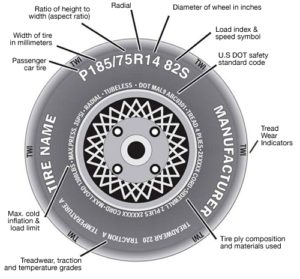There’s a great deal of information on a tyres sidewall that identifies a tyres construction and its capabilities.

| Tyre sidewall example: P185/75R14 82S | ||
| Service type: | P | Indicates the service type of a vehicle tyre. In this case the tyre is a Passenger vehicle tyre, as opposed to a tyre made for a light truck (LT) or other vehicles. |
| Section width: | 185 |
The width of a tyre in millimeters from sidewall to sidewall. This measurement varies depending on the width of the rim to which the tyre is fitted: larger on a wider rims and smaller on a narrow rims. The number on the side of the tyre indicates the width measured with the tyre fitted to the recommended rim width. |
| Aspect ratio: | 75 | The ratio of height to width. In this case the tyres height is 75% of its width. |
| Internal construction: | R |
How the plies are constructed in the tyres carcass. ‘R‘ means the tyre is constructed with a radial internal construction. ‘B‘ means the tyre is constructed with a belted bias construction. ‘D‘ means the tyre is constructed with a diagonal bias construction. |
| Rim diameter: | 14 | The diameter of the wheel in inches. |
| Load index: | 82 | In this case the tyre has an industry-standard maximum load of 475 kg (1,047 lbs.). Different load index numbers correspond to different maximum load indexes. The maximum load is shown in lbs. (pounds) and in kg (kilograms). The maximum pressure is shown in PSI (pounds per square inch) and in k Pa (kilo-pascals). |
| Speed rating: | S | In this case the tyre has an industry-standard maximum service speed of 130 mph. Different letters correspond to different maximum service speeds. |
Here are some other markings to look for on your tyre sidewalls:
 |
The mountain/ snowflake symbol indicates a Severe Snow Conditions rating – the safest tyres for any kind of driving in cold weather environments. These tyres have been designed specifically for use in cold weather and severe snow conditions, and have been performance tested as meeting or exceeding industry established snow traction performance requirements. |
 |
The M+S (also displayed as M&S or M-S) indicates the tyre has all season condition capabilities. Tyres bearing this mark offer great traction and can be used in rain, snow, and muddy conditions. This designation indicates a specified tread-to-void ratio; however it does not mean that the tyre has passed any road tests ensuring effectiveness in severe winter conditions. |
| Maximum Inflation Pressure is the highest inflation pressure that a tyre can withstand. This is not, however, the recommended inflation pressure. Inflation pressures should never be below the pressure recommended by your vehicle manufacturer or above the maximum pressure branded on the tyres sidewall. | |
Tyre & Sidewall Glossary
| Tyre Tread: |
The flat area of the tyre that contacts the road surface. A tyres tread construction determines the adhesion characteristics of a tyre in all driving conditions. |
| Tyre Bead: |
The narrow band that anchors the tyre to the rim and maintains a leak-free seal. This area transmits acceleration, turning, braking and all other forces between the vehicle and the road. |
| Tyre Sidewall: |
The vertical portion of the tyre that extends from the road surface to the bead. Sidewall construction and depth affects the ride and handling of the tyre. A narrow, stiff sidewall offers more responsive steering, but a deep, supple sidewall will flex to provide a smoother ride. |
| Tyre Shoulder: | The curved region where the vertical sidewall of the tyre meets the horizontal tread. |